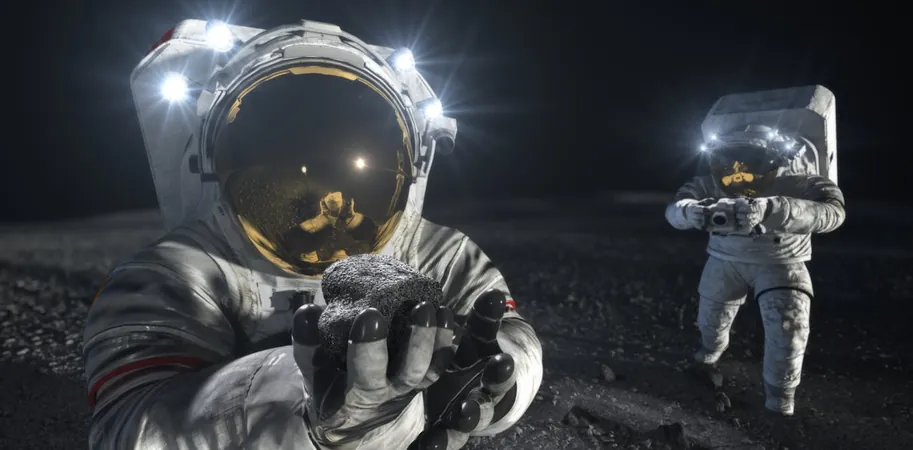
US and China Prepare for Lunar Dominance: Are Space Laws Ready for the Challenge?
2025-01-03
Author: Mei
Outer space may be boundless, but human ambition seeks to lay down laws across its vast expanse. As the space race heats up again, both the United States and China are making significant strides toward returning humans to the Moon. Each nation harbors plans to establish long-term research stations, mirroring the international presence seen in Antarctica.
However, as these two superpowers gear up for their lunar endeavors, the potential for conflict simmers beneath the surface. Questions arise about territorial claims and resource rights on the Moon. With vital water ice deposits hidden in shadowy craters at the lunar poles, the looming prospect of “space water wars” could surge to the forefront, making it a more immediate issue than providing clean drinking water to those in developing nations.
Diving into the complexities of international space law, we discover a tangled web of treaties and agreements that govern outer space activities. The cornerstone of this framework is the 1967 Outer Space Treaty, which asserts that space should be “free for exploration and use by all states” and explicitly forbids any nation from claiming sovereignty over celestial bodies. Hence, nations seeking to establish lunar bases for resource extraction might find themselves on legally shaky ground, as this treaty encourages collective exploration rather than individual ownership.
There is a crucial paradox embedded in the treaty; while it allows countries to maintain jurisdiction over their space-faring objects, this could impede others from accessing or utilizing nearby resources. Also noteworthy is the Moon Agreement from 1979, which prohibits any nation from claiming ownership of lunar territory or resources. Unfortunately, most significant spacefaring nations, including the US, Russia, and China, have not adopted this agreement, creating a gaping hole in the legal framework.
In response to the lack of a cohesive set of laws around the Moon's resources, the US introduced its own Artemis Accords in 2020, which seeks to define best practices for resource extraction on the Moon. Yet these accords lack the endorsement of heavyweights like China and Russia, further complicating the landscape.
The exploration for ice resources is crucial not only for sustainability at lunar bases but also for further deep space missions that could span millions of miles. Meanwhile, a burgeoning industry focusing on asteroid mining is emerging, with companies aiming to harvest lucrative minerals while confronting the same legal quandaries around repatriating resources to Earth.
Furthermore, the implications of space law stretch beyond our Solar System. Under the Outer Space Treaty and related conventions, nations are held liable for damages caused by their space activities, raising questions about accountability as spacecraft wander farther into the cosmos. With probes like Voyager already beyond our Solar System, can nations still be held responsible for potential pollution caused by these distant explorers?
As we push the limits of our space endeavors, clarifying these legal ambiguities becomes critical. Spacefaring ambitions are rapidly evolving beyond just our immediate neighborhood. With missions to gather data from celestial bodies like Mars and potential habitats well beyond our Solar System, the enforcement of space law must evolve. The challenge remains: can we effectively govern human actions in the vastness of space? As the US and China enter a new lunar frontier, the future of space law hangs in the balance, potentially leading to unprecedented conflicts as these nations jockey for cosmic supremacy.
Stay tuned as we observe the unfolding developments in space law and the race for lunar dominance!



 Brasil (PT)
Brasil (PT)
 Canada (EN)
Canada (EN)
 Chile (ES)
Chile (ES)
 Česko (CS)
Česko (CS)
 대한민국 (KO)
대한민국 (KO)
 España (ES)
España (ES)
 France (FR)
France (FR)
 Hong Kong (EN)
Hong Kong (EN)
 Italia (IT)
Italia (IT)
 日本 (JA)
日本 (JA)
 Magyarország (HU)
Magyarország (HU)
 Norge (NO)
Norge (NO)
 Polska (PL)
Polska (PL)
 Schweiz (DE)
Schweiz (DE)
 Singapore (EN)
Singapore (EN)
 Sverige (SV)
Sverige (SV)
 Suomi (FI)
Suomi (FI)
 Türkiye (TR)
Türkiye (TR)
 الإمارات العربية المتحدة (AR)
الإمارات العربية المتحدة (AR)